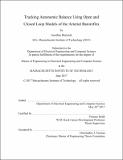| dc.contributor.advisor | Thomas Heldt. | en_US |
| dc.contributor.author | Birjiniuk, Jonathan | en_US |
| dc.contributor.other | Massachusetts Institute of Technology. Department of Electrical Engineering and Computer Science. | en_US |
| dc.date.accessioned | 2017-12-20T17:24:34Z | |
| dc.date.available | 2017-12-20T17:24:34Z | |
| dc.date.copyright | 2017 | en_US |
| dc.date.issued | 2017 | en_US |
| dc.identifier.uri | http://hdl.handle.net/1721.1/112833 | |
| dc.description | Thesis: M. Eng., Massachusetts Institute of Technology, Department of Electrical Engineering and Computer Science, 2017. | en_US |
| dc.description | This electronic version was submitted by the student author. The certified thesis is available in the Institute Archives and Special Collections. | en_US |
| dc.description | Cataloged from student-submitted PDF version of thesis. | en_US |
| dc.description | Includes bibliographical references (pages 93-96). | en_US |
| dc.description.abstract | The arterial baroreceptor reflex is the major blood pressure control loop mediated by the autonomic nervous system (ANS). It supports arterial blood pressure homeostasis by dynamically adjusting heart rate, vascular resistance, venous tone, and cardiac contractility. Accurate quantitative models of the baroreflex would provide physiological insight, and could allow for real-time tracking of ANS activity in clinical settings. Prior work has concentrated on modeling the baroreflex nonparametrically with linear transfer functions, or parametrically as an autoregressive moving average model. In this work, we formulate beat-to-beat, open and closed loop models of the heart rate arc of the baroreflex. Model structure and parameterization are explicitly based on prior physiological insights of the response dynamics of the sympathetic and parasympathetic branches of the ANS. We analyze the models' ability to track changes in autonomic balance using data from a dual pharmacological blockade and postural study. Our results show that the open loop model parameters faithfully track changes in autonomic balance resulting from changing posture and autonomic blockade, whereas the closed loop model parameters do not. Sensitivity analyses are conducted on the open-loop model parameter estimation, which proves to be robust in the presence of varying levels of noise. Overall, the contributions of this thesis further the goal of obtaining real-time information about the ANS. | en_US |
| dc.description.statementofresponsibility | by Jonathan Birjiniuk. | en_US |
| dc.format.extent | 96 pages | en_US |
| dc.language.iso | eng | en_US |
| dc.publisher | Massachusetts Institute of Technology | en_US |
| dc.rights | MIT theses are protected by copyright. They may be viewed, downloaded, or printed from this source but further reproduction or distribution in any format is prohibited without written permission. | en_US |
| dc.rights.uri | http://dspace.mit.edu/handle/1721.1/7582 | en_US |
| dc.subject | Electrical Engineering and Computer Science. | en_US |
| dc.title | Tracking autonomic balance using open and closed loop models of the arterial baroreflex | en_US |
| dc.type | Thesis | en_US |
| dc.description.degree | M. Eng. | en_US |
| dc.contributor.department | Massachusetts Institute of Technology. Department of Electrical Engineering and Computer Science | |
| dc.identifier.oclc | 1015200344 | en_US |
